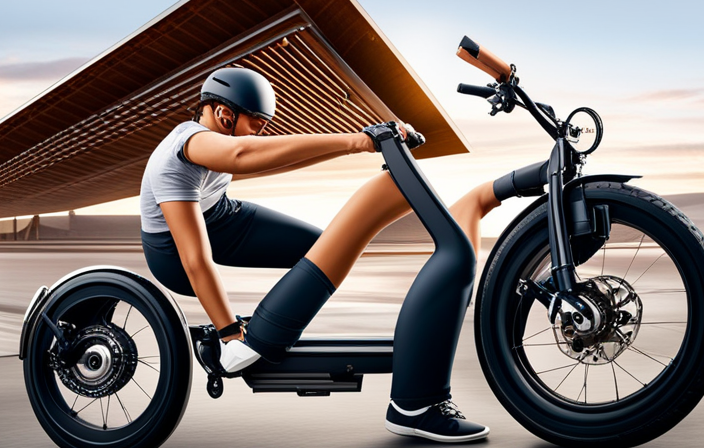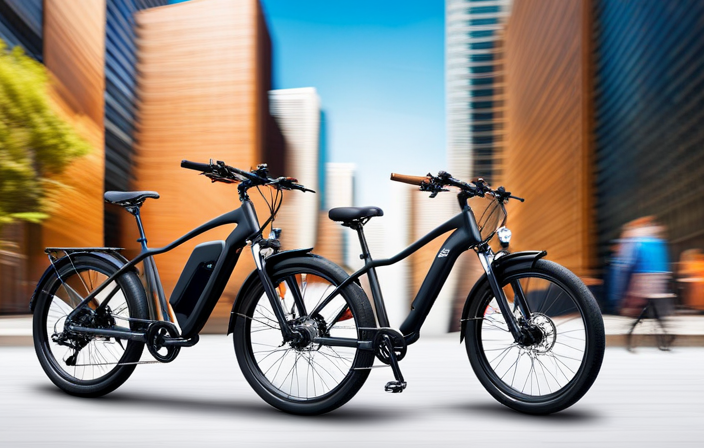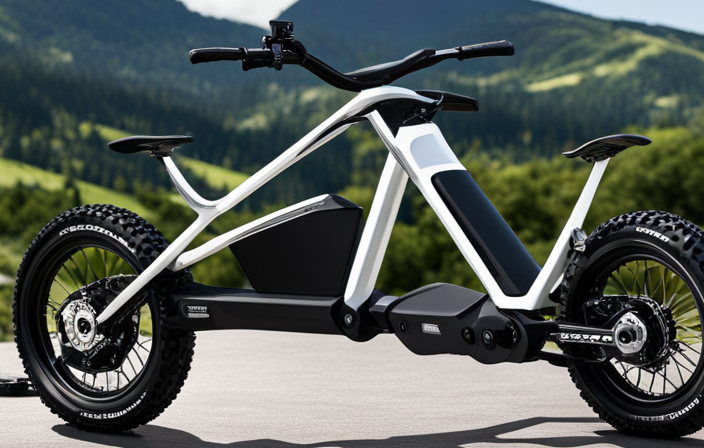So, you’ve had an unexpected electric bike accident in sunny Florida. While it’s ironic that your leisurely ride took an unexpected turn, it’s important to know what steps to take next.
In this article, we’ll guide you through the necessary actions to ensure your safety, seek medical attention if needed, report the incident, gather evidence, exchange information, notify your insurance company, and ultimately seek compensation for any damages or losses you may have incurred.
Stay informed and empowered in the aftermath of your electric bike accident.
Key Takeaways
- Familiarize yourself with the statute of limitations for personal injury claims in Florida.
- Seek compensation for damages and losses after an electric bike accident.
- Seek emotional support and take action to protect your rights.
- Consider hiring an experienced personal injury attorney for legal representation and guidance.
Ensure Your Safety and Seek Medical Attention if Necessary
Make sure you’re safe and seek medical attention if needed.
The first thing to consider after an electric bike accident in Florida is your safety. It is crucial to wear protective gear, such as a helmet, when riding an electric bike to minimize the risk of injuries.
Common causes of electric bike accidents include distracted riding, speeding, and not following traffic rules. To prevent these accidents, always stay focused on the road, obey speed limits, and follow all traffic laws.
If you have been injured in an electric bike accident, seek immediate medical attention. Even seemingly minor injuries can have long-term effects.
Once you have ensured your safety and received medical care, it is important to contact the authorities and report the accident, which we will discuss in the next section.
Contact the Authorities and Report the Accident
Contact the authorities and report the incident as soon as possible. It is important to notify the appropriate authorities so they can document the accident and create an official report. In the state of Florida, electric bikes are subject to the same laws as bicycles, so it is crucial to understand the specific regulations that apply to electric bikes. To ensure you have a comprehensive understanding of your rights and potential legal options, consider contacting a personal injury lawyer who specializes in electric bike accidents. They can provide guidance and support throughout the legal process. Gathering evidence and documenting the scene will be the next step in building your case. It is crucial to gather any relevant information such as witness statements, photographs, and medical records to support your claim.
Gather Evidence and Document the Scene
Once you’ve contacted the authorities and reported the incident, it’s essential to gather evidence and document the scene of the accident.
Preserving evidence is crucial for any legal actions or insurance claims that may follow. Take photographs of the accident scene from various angles, capturing any damages to your electric bike and any other vehicles involved. Be sure to also photograph any visible injuries you sustained.
In addition to photographs, gather any other relevant evidence, such as witness statements or video footage if available. This documentation will help establish the facts of the accident and support your case.
After gathering evidence, you can then proceed to exchange information with the other party involved, ensuring all necessary details are recorded for future reference.
Exchange Information with the Other Party Involved
When exchanging information with the other party involved, make sure to gather all necessary details for future reference. This includes their name, contact information, and insurance information.
It is important to document the incident accurately to protect yourself from any potential legal implications. Exchange information calmly and politely, ensuring that you understand each other’s insurance coverage.
Take note of any witnesses present and obtain their contact information as well. This will be helpful if there are any disputes or questions about the accident later on.
Once you have gathered all the necessary information, it is important to notify your insurance company of the incident. This will allow them to begin the claims process and provide you with the necessary guidance moving forward.
Notify Your Insurance Company
Make sure to let your insurance company know about the incident as soon as possible.
It’s important to notify your insurance company about the electric bike accident in Florida to ensure that you are covered for any damages or injuries sustained.
Contact your insurance provider and provide them with all the necessary details, such as the date, time, and location of the accident, as well as any other relevant information. They will guide you through the claims process and help determine the extent of your coverage.
It’s essential to be proactive and inform your insurance company promptly, as delays may result in complications or potential denial of coverage.
After notifying your insurance company, it is advisable to consult with an attorney specializing in personal injury to discuss your legal options and potential compensation.
Consult with an Attorney Specializing in Personal Injury
After notifying your insurance company of the electric bike accident, it is crucial to consult with an attorney specializing in personal injury. This step is essential to protect your rights and ensure you receive the compensation you deserve.
Finding a reputable attorney who understands the legal process can make a significant difference in the outcome of your case. They will guide you through the complexities of the legal system, handle all the necessary paperwork, and negotiate with insurance companies on your behalf. An experienced attorney will fight for your best interests, ensuring you receive the maximum compensation for your injuries, medical expenses, and other damages.
With their expertise, you can focus on your recovery while they handle the legal aspects of your case.
Now, let’s move on to the next section about following up with medical treatment and keeping records of your expenses.
Follow Up with Medical Treatment and Keep Records of Your Expenses
To ensure your legal case is strong, it’s important to follow up with medical treatment and keep detailed records of your expenses. This will not only help you recover from your injuries, but also provide evidence of the damages you have incurred.
Make sure to keep all receipts related to your medical treatment, including doctor visits, medications, and any therapy or rehabilitation sessions. In addition, keep a record of any out-of-pocket expenses, such as transportation costs to and from medical appointments.
It’s also crucial to obtain copies of your medical records, which will document your injuries and the treatment you have received. These records will play a vital role in proving the extent of your damages and supporting your claim.
Speaking of which, filing a claim with the relevant insurance companies is the next step in seeking compensation for your electric bike accident in Florida.
File a Claim with the Relevant Insurance Companies
Filing a claim with the appropriate insurance companies is the next step in seeking compensation for your injuries sustained while riding an e-bike in Florida. It is important to understand that the insurance coverage for electric bikes may vary depending on the policy you have. To help you navigate this process, here is a breakdown of the insurance coverage limits that may apply:
| Insurance Company | Coverage Limit |
|---|---|
| Auto Insurance | Varies |
| Health Insurance | Varies |
| Homeowner’s Insurance | Varies |
Make sure to contact each insurance company to determine if your policy covers electric bike accidents and what the specific coverage limits are. This will help you understand the potential compensation you may receive. Additionally, stay informed about the legal process and your rights to ensure you are taking the necessary steps towards a fair resolution. Transitioning into the next section, it is crucial to stay informed about the legal process and your rights while pursuing your claim.
Stay Informed about the Legal Process and Your Rights
Make sure you stay informed about the legal process and your rights throughout the claims process for your e-bike injuries in Florida. Understanding the statute of limitations is crucial, as it sets a time limit for filing a lawsuit after an accident.
In Florida, the statute of limitations for personal injury claims is generally four years from the date of the accident. Familiarize yourself with this timeframe to avoid missing out on the opportunity to seek compensation.
Additionally, seeking emotional support is essential during this challenging time. Reach out to friends, family, or support groups who can provide guidance and understanding. Remember, you don’t have to go through this alone.
By staying informed about the legal process and seeking emotional support, you can navigate the claims process more effectively and ensure your rights are protected.
Now, let’s move on to seeking compensation for damages and losses.
Seek Compensation for Damages and Losses
Seeking compensation for damages and losses can help you recover financial losses and receive the support you need during this challenging time. After an electric bike accident in Florida, it is important to understand your compensation eligibility.
In Florida, if you have been injured due to someone else’s negligence, you may be entitled to compensation for medical expenses, lost wages, pain and suffering, and other damages.
To navigate the legal process effectively, it is crucial to consider your legal representation options. Hiring an experienced personal injury attorney can greatly increase your chances of receiving fair compensation. They will guide you through the entire process, gather evidence, negotiate with insurance companies, and represent your best interests in court if necessary.
Remember, seeking compensation is your right, and having the right legal representation can make a significant difference in the outcome of your case.
Frequently Asked Questions
How can I ensure my safety after an electric bike accident in Florida?
To ensure your safety after an electric bike accident in Florida, it is crucial to seek immediate medical attention. By promptly receiving medical care, you can address any injuries and ensure the best chance of a full recovery.
What should I do if I believe the other party involved in the accident is at fault?
If you believe the other party is at fault, it’s crucial to gather evidence like photos and witness statements. Contact legal representation specializing in personal injury cases to help prove fault and protect your rights.
Is it necessary to notify my insurance company even if I don’t believe I am at fault?
Notify your insurance company even if you don’t believe you’re at fault. They can guide you through the fault determination process and provide assistance with any potential claims or legal matters that may arise.
What expenses can I include in my claim with the relevant insurance companies?
You can include medical expenses and lost wages in your claim with the relevant insurance companies. It’s important to gather all necessary documentation and provide it to the insurance company to support your claim.
How long does the legal process usually take for a personal injury case related to an electric bike accident in Florida?
The legal process for a personal injury case related to an electric bike accident in Florida can vary. On average, it takes several months to a few years to reach a settlement. To file a personal injury claim, follow these steps.
Conclusion
In conclusion, after an electric bike accident in Florida, it’s crucial to prioritize your safety and seek medical attention if needed.
Contact the authorities and report the incident, gathering evidence and documenting the scene.
Exchange information with the other party involved and notify your insurance company.
Follow up with medical treatment and keep records of expenses.
Stay informed about the legal process and your rights, seeking compensation for damages and losses.
Remember, in the midst of a challenging situation, taking the necessary steps can lead to a brighter outcome.
Stay safe and take care.









